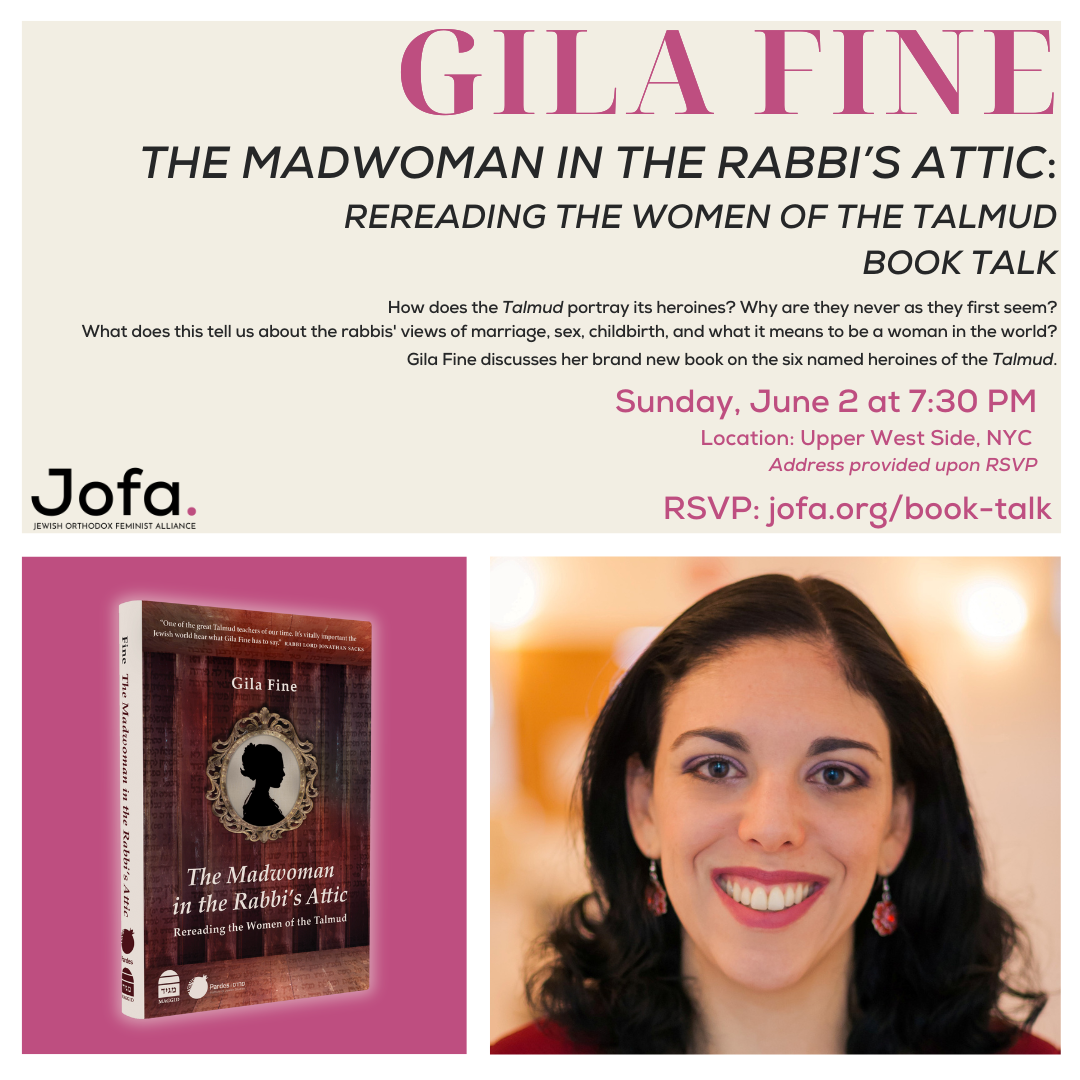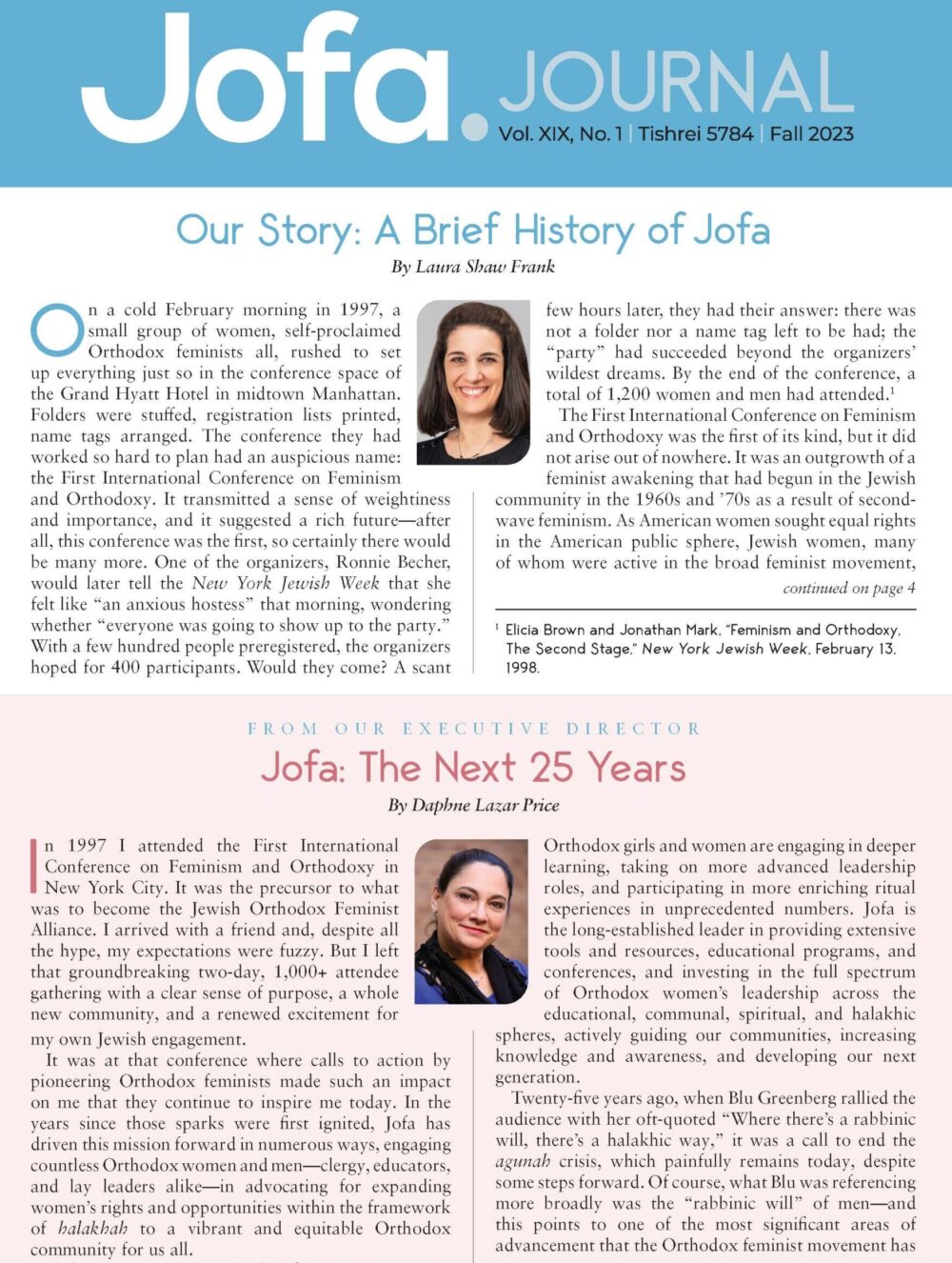By Blu Greenberg
Item: A Modern Orthodox community in Queens, New York, celebrating an aufruf, holds Shabbat services in the social hall of the local yeshiva. The opaque mehitzah separating front from back is hung ceiling to floor, completely blocking sightlines. The rabbi, much beloved by his community, delivers his sermon in a voice inaudible to the women. He must be aware of this, because when he praises the groom’s mother, a pillar of the community, he raises his voice so all can hear. I have the urge to call out, “Heicher, heicher” (“higher, higher”) using the traditional cry of hard-of-hearing shul-goers, but as a first-time guest, I mind my manners. After davening, I hear clusters of women complain that they could not hear the rabbi—and that he often does this. I am taken aback. Why did they not protest, call out?
Item: My flight is delayed and lands in Tel Aviv on a Friday afternoon, twenty minutes before candle lighting. I call my children in Ra’anana to say I won’t make it, leave my luggage at the airport, and check into a hotel nearby. On Shabbat morning, the concierge directs me to the closest synagogue, and I make my way up to the ezrat nashim. The lights are off, the place is dusty, and a few chairs are overturned. Prayer books open on the ledges are mahzorim from Yom Kippur—and this is February. More surprising, a bar mitzvah is taking place below, yet I am the sole resident of the ezrat nashim. The mother and a throng of female relatives arrive after services, bringing bourekas.
Item: I am at a Jewish renewal retreat with my husband. The group’s organizers have decided that there should be a variety of minyanim to choose from, but eliminate the Orthodox minyan on grounds of sexism. The few Orthodox Jews present, mostly men, protest. I do too. Our minyan is reinstated, and I join it, even though a women’s service run by liberal women is offered simultaneously. No one is going to take my Orthodox minyan away from me. My feminist sisters are surprised.
Item: Every summer for the past few decades, we have davened at a Chabad shul in Aspen, Colorado. The new building is magnificent—large windows and light wood everywhere. We praise God looking out on the beautiful scenery of mountains, trees, and sunlight. For the past many years, the mehitzah separating the two sides has been potted plants—a divider that feels inclusive. The rabbi often invites his Hasidic colleagues for Shabbat, and nothing is changed for them by the manifest presence of women. I have concluded that this is what a Hasidic, yeshivish, hareidi mehitzah could look like.
What Is the Future of the Ezrat Nashim?
The ezrat nashim, an ancient yet modern feature of traditional Judaism, makes a clear statement about women’s place in communal prayer—marginal and at the periphery. At this time in human history, when “separate but equal” has been challenged in the broader culture as retrogressive, when internally so many aspects of Orthodox women’s lives have come under the microscope and so much has changed, it is surprising that the ezrat nashim/mehitzah configuration has escaped the feminist gaze.
A specific mehitzah might arouse debate in local communities—but a broad critique? To my knowledge, mehitzah is not now, and has never been, an agenda item of any Orthodox women’s organization. None of the new partnership minyanim seeking to increase inclusivity have questioned traditional mehitzah seating. Recently, the Orthodox cohort of the Women of the Wall rejected the compromise offer of new space at the Western Wall because it was not the “real” Kotel and because, in consideration of the liberal denominations, the proffered space included no standing mehitzah, only an ad hoc one. This was too high a bar for women who had heretofore prayed exclusively in designated women’s spaces.
The paradox is this: Objectively, the ezrat nashim can be catalogued as inferior to men’s space, with second-class status accruing to its inhabitants. Outsiders view mehitzah as demeaning to women. Yet insiders accept it, often with great equanimity, and even relief. This includes those who enter the community from a modern social reality and fall in without a complaint. In a JOFA survey of women-friendly shuls, one respondent from a shul with many ba’alei teshuva wrote, “Our shul is full of people who are surprised to see themselves in a shul with a mehitzah, and even more surprised that they like it.” In fact, I must admit that when sight and hearing lines and comfort levels are satisfactory, I rather like it myself—a proud feminist feeling a surprising tinge of pleasure, as I make my way to the back or side or even upstairs to the women’s section. Added value: mehitzah is the price we willingly pay to remain part of the community we love.
Still, in Queens, the women fumed. Why did they and their Barnard-educated daughters not protest? Were their husbands aware yet failed to speak out? Would I have called out “Heicher” in my own shul?
Other questions: Where are we headed with the surprising inconsistency of wanting both women rabbis and mehitzot? Does the ezrat nashim serve a function in Jewish communal life? What mysteries of gender does mehitzah unlock? Why do I want to defend it even as I critique it?
Mehitzah’s Staying Power: Some Tentative Answers
Fidelity to tradition and halakhah play the largest role. The ezrat nashim was a feature of the Holy Temple in Jerusalem for Simhat Beit Hasho’eivah and was universally maintained in Jewish communities throughout pre-modern times. Thus, it yields both a sense of continuity and the deep satisfaction that come from observing halakhah.
Mehitzah was not always the sine qua non that it has become in American Orthodoxy. In the first half of the twentieth century, many Orthodox shuls, especially in the South and West, had mixed seating. However, at mid-century, as denominational lines hardened and more hareidi Jews arrived on these shores, mehitzah became a more stringent requirement. In the 1950s, Rabbi J.B. Soloveitchik ruled that it was better to stay at home and miss the Rosh Hashanah shofar blowing than to daven in a mixed-seating congregation, because the fulfillment of the mitzvah of shofar would be as invalid as the service. The Orthodox Union (OU) directed its member shuls to install mehitzot within three years or be expelled. Today, the three-year window no longer exists.
At a personal level, mehitzah has also become an identity badge of sorts—a shorthand summary of how we live our daily Jewish lives, of which our time in shul is but a small part.
There is also a powerful convergence in the mehitzah of halakhah, politics, and communal identity that goes beyond one’s ritual practice. Incongruously, a person can be halakhicly meticulous and belong to a liberal congregation that lacks a mehitzah and another can be a non-observant member of an Orthodox shul with a mehitzah, and each will carry his or her synagogue’s denomination label.
Another factor in the staying power of mehitzah is the great range and variety of structures, from potted plants to women-are-taboo-floor-to-ceiling dividers. One can often (but not always) find a community with an ezrat nashim that meets one’s needs. Just as the eruv is a fact to check before moving to a new community, so is the ezrat nashim.
This range of mehitzot suggests two things: a flexibility in interpreting the law and the extent to which community sensibilities play a role in the process. As Orthodoxy was expanding to the suburbs in the mid-twentieth century, Rabbi Soloveitchik was brought to these communities to determine mehitzah height; he was known to give differing responses depending on the community’s character. Within individual shuls today, the mehitzah has been raised or lowered (mostly raised) as neighborhoods and rabbis change. Recently, a shul in Modi’in installed a one-way glass wall mehitzah to enable the women to feel more central to the services. Rabbinic authorities were consulted, but the entire project was community-driven.
The ezrat nashim reflects and enables the halakhic distinctions between men and women in prayer obligation. Women’s exemption from time-bound commandments is a complex, scholarly matter, but the widely held popular view is that women have little responsibility for communal prayer at set times. This conviction holds true even when it flies in the face of halakhic sources: Women are obligated in Shabbat morning prayers and Torah reading, but are exempt from mussaf, the additional Sabbath prayer. Yet the majority of Orthodox women do exactly the opposite—they arrive during or at the end of Torah reading and diligently recite mussaf, a tradition of sorts.
Without an ezrat nashim, a woman arriving an hour after her husband would have to scramble to find a seat alongside him or, awkwardly, sit next to someone else’s husband while her own sits a few rows ahead. In non-Orthodox synagogues, families arrive together; in most Orthodox shuls, husbands precede their wives, who are home readying the children or preparing Shabbat lunch or simply setting out at the hour that generations of women before them set out. The ezrat nashim fits this model of two-tiered, gender-differentiated prayer obligation unique to Orthodoxy.
Thus, it could be said that the ezrat nashim serves another important function: It brings women to shul, and to prayer—in numbers smaller than men, but significant nevertheless. As with many other curiosities of life, mehitzah gives dual messages: inviting and disinviting, welcoming and off-putting. Yet without it, many Orthodox women would have no prayer experience at all.
Sociability and Gender-Bonding Factors
Still, there must be more to explain the staying power of the ezrat nashim. I believe there are additional satisfactions and compensations beyond fidelity to law and social conditioning that explain why mehitzah has escaped the accusation of sexism and will not find a place on the Orthodox Jewish feminist agenda any time soon.
First is the sociability element: People come to the beit knesset (literally, the gathering place) to pray and to see their friends. An Orthodox shul is a highly active social experience. Rav Soloveitchik wrote compellingly about mehitzah prayer as a framework for being alone with God rather than as part of a family unit. Yet it is easy to observe that another function operates simultaneously: Orthodox shuls pulse with life in extra-familial, cross-generational friendships, largely as a result of nonfamily seating.
Proof of that sociability is its downside—noise. There is simply more chatter in an Orthodox shul than in other liturgical settings. This can disrupt and distract those who seek an intense prayer experience. Every shul, therefore, should offer a course in “Whispering 101” to protect the kavvanah of the true daveners. It would also remind all present that even though socializing is of special value, the real purpose is prayer—if not one’s own, then that of the person within earshot.
Second is the gender-bonding function of mehitzah seating. We do not know everything about men’s space and women’s space, but we do know that once the hierarchical aspects are controlled, gender bonding can be a satisfying experience for both genders. We have all observed in contemporary social settings how men and women segregate of their own accord.
Third, mehitzah highlights the mystery of human sexuality. In a world that increasingly blurs gender distinctiveness, the separate-seating shul has an almost palpable feeling of maleness and femaleness, a pervasive and satisfying mystery to many and one that does not intrude into one’s prayer relationship with God.
Some claim that when men and women sit together, sexual attractions emerge and disrupt the process of turning one’s heart to God. Yet friends who pray in liberal synagogues say that except for an occasional provocatively dressed visitor (who might also show up at an Orthodox simhah) the mixed seating arrangement is conventional and asexual. Paradoxically, then, the Orthodox separate seating immediately underscores the gender binary. For people troubled by the blurring of gender lines, the frank affirmation of the sexual factor while simultaneously shielding it, can be comforting. Conversely, for those who feel that sex is all too pervasive in media, commerce, and arts, the old-fashioned separation becomes a statement against excess and the synagogue becomes an oasis of gentility.
Of course, all of these claims of advantage in gender distinctions now come under question as the long-suppressed sexual minorities assert their visible presence in society’s institutions, including the synagogue. With new cultural awareness that LGBT orientations are largely biologically determined and are found in all population clusters in roughly the same ratios, synagogues are beginning to deal with the questions this raises about human sexuality and community. This is uncharted territory and the Orthodox synagogue, with its unique seating arrangement, can be of help in charting new paths of understanding.
The Conflict between Ezrat Nashim and Women’s Prayer/Spiritual Lives
Having made the case that mehitzah seating has its own rewards and staying power, let me turn to the problematics of the phenomenon. (I hear the voice of my friend Belda Lindenbaum, z”l, in my ears. “Don’t let them off so easy!” She always pressed forward with the truth: “Don’t let ourselves off so easy!”)
Many mehitzot perpetuate their original design function—to remove from sight of the serious petitioners those distracting, levity producing sex objects. What does it mean in the year 2016 to install a one-way mirror in a Modern Orthodox shul? What is the message of a shul rebuilt in the last decade that assigns women to floor 2 and carves out a square hole between floors so that women can follow the main conversation taking place on level 1? Siren and “second string” are the messages transmitted, not comfort and gender bonding.
And those are the easy objections. The bottom line is that mehitzah’s main impact is not on women’s dignity or equality, but on women’s prayer. Hannah’s model for the central Jewish prayer notwithstanding, women and tefillah are not a core feature of traditional Judaism. Do we “rather like it” because it is so easy not to have to daven, not to make the effort? Is it because, as my friend Carla, z”l, said years ago about women and prayer, and re-articulated by many others, “I have enough mitzvot on my plate; I don’t need more!”
Whether lack of firm obligation or unique spatial arrangement is the driving force, it is the interplay of the two that has delivered women to a back seat in the Jewish prayer enterprise. The vast majority of Modern Orthodox women, including women with deeply religious souls, do not daven every day nor recite fixed prayers. The small numbers of committed female daveners are drawn largely from the community of women learners and teachers. The process of opting out begins early. A teacher at a yeshiva high school observes that as soon as the girls pick up a siddur at the morning minyan, a veil drops over their eyes.
Even if a woman starts out with regular prayer, the likelihood of her persisting with it throughout life is small. Although some women do manage to daven regularly even through childbirth and child care (for which the exemption makes great sense), it is rare, so rare that I still recall my wonderment 42 years ago in Kibbutz Yavneh, when I knocked at the door of Rena, z”l. I knew that Rena, then a young mother of three, was inside, so I knocked and waited, knocked and waited. This was at the beginning of my feminist engagement, and there were no extant models of women and daily tefillah, so it simply never occurred to me that what was going on behind that door had anything to do with prayer. Finally, a tiny figure opened the door and said, “Ema mitpallelet” (Mommy is praying). Even now, when I hardly feel like pushing myself to shul on a cold Shabbat morning, I hear that small voice and think of Rena.
The larger question for women is this: Are we missing out on the extraordinary opportunity to enter into a personal and private conversation with God? Among men, such experiences do take place, even if but once a month or once a year. But only if the prayer dice are rolled every day, no matter how routinely, will that deep moment of encounter ever happen.
What else have we lost? Jewish prayer is a worldview of life as much as it is a discourse with God. What if we wake up years from now to find that we have missed out on a daily experience of awe at nature, or the solace that accompanies a heartfelt request, or the powerful sense of being a member of the covenantal community, at one with the Jewish people everywhere? What if we come to realize that by taking that back seat all these years, we have forfeited a thousand nourishing soul surges of profound gratitude or humbling vulnerability or ennobling humility that come with daily prayer?
For centuries, women were deprived of the richness of text learning, but we did not know it until our own generation. Now, many women are making the effort and finding Torah sweeter than honey and the honeycomb (Psalms 19:11), its intellectual and spiritual rewards incalculable. Unlike learning, to which thirsty women came in droves on their own initiative, prayer is something to which only small percentages have come. Whereas learning is immediately rewarding, prayer may not be. All this reflects the level of difficulty that must be overcome for modern men and women to pray.
Thus, we must ask the hard question, the question many of us do not want to ask or hear: Should our newfound sense of Jewish maturity inspire us to question the exemptions we find so inviting? When prayer is commanded, many men find a way to overcome all obstacles and fulfill the call. The sense of obligation becomes more important to motivate steadfast pursuit of all mitzvot—from which we then reap the inner rewards. We Orthodox Jews know this in our bones; we live by the sense of being obligated.
What Can We Do Now?
This is all a slow process. Meanwhile, interim tasks need our attention. The first order of business is to ensure that the ezrat nashim conforms to the gender model of distinctive but equal, one that can suit the most egalitarian and the most traditional shul alike. Women and men working together should establish universal standards that show respect and appreciation for women’s presence. No congregation should have to struggle alone to define what this repair should look like.
Every mehitzah, every ezrat nashim, is different from every other, but all must meet essential criteria of inclusiveness to qualify under the coveted canopy of an inclusive Orthodox shul. Clear sight and sound lines to the aron hakodesh, the shulhan from which the Torah is read, and the bimah from which the rabbi teaches are basic requirements. The rabbi should pause to inquire whether women in the ezrat nashim can hear without straining. During the derashah, the speaker should remember to regularly glance at the women’s section to confirm that they are part of the flock. Women should be able to kiss the Torah as it is carried through the ezrat nashim or along the rim of the mehitzah. Wheelchair accessibility should be provided; in shuls where the ezrat nashim is a balcony, a portion of dedicated mehitzah seating should be provided on the main floor for older or infirm women. Siddurim and humashim on both sides of the mehitzah should be relatively uniform and in good condition, not cast-off volumes with torn bindings and missing pages. Signs hung on the walls of the men’s section noting special prayers or ritual symbols evoking national memory should be large enough to be read or seen by women or should be duplicated on the ezrat nashim walls. At least some portion of the service should have a woman’s voice—from announcing pages or greeting guests to leading prayers for Israel’s soldiers or delivering sermons.
The mehitzah should meet some elemental objective standard of beauty. A manual on how to create an ezrat nashim of inclusiveness should be published, with some personal tales of the process and a list of dos and don’ts. A companion book of photographs of mehitzot around the world—the good and the bad—should be circulated, as a picture is worth a thousand words.
When a dignified ezrat nashim becomes standard operating procedure in Orthodox shuls, we will have gone far to separate it from being a vehicle of marginalization. The next step for our community is to explore how the new woman can stand before God on a regular basis. We must take the time to look at the factors that dull her sense of responsibility and diminish her level of performance. We must re-examine the sources, probe the pervasiveness of the exemption, and lift up the obligation—perhaps differentiated in some ways from men’s prayer, perhaps incorporating some of the new prayers of recent generations. We cannot keep our heads in the sand.
If, in the end, women’s active participation in prayer and encounter with God will lead us to question the institutions of ezrat nashim, mehitzah, and obligation, we must do so. Some will say that such ideas are an assault on the word of God as expressed in established practice. But, as with women’s learning, we need not protect God from this enterprise of religious growth. The Talmud teaches, “God wants the heart” (Sanhedrin 106b), and no one would deny: the heart of man and woman alike.
To the women who hesitate, who feel no urge to find themselves in prayer, we must remember that we are all born with a prayer reflex which, if not strengthened, will atrophy with time. Worse, through non-action, we inflict that loss on the generations to come. At a time when our community has accomplished so much in extending Torah’s bounty to all women, why should it leave in place the barriers that will deprive our daughters and granddaughters of the Divine encounter, community connections, uplift, tranquility, and other magnificent gifts that come with prayer?
Blu Greenberg is the founder and first president of JOFA.
[callouts, if necessary] i hope that these can all remain, and i would choose something else to take out if necessary.
The range of mehitzot suggests two things: a flexibility in interpreting the law and the extent to which community sensibilities play a role in the process.
Mehitzah’s main impact is not on women’s dignity or equality, but on women’s prayer.
Every mehitzah, every ezrat nashim, is different from every other, but all must meet essential criteria of inclusiveness to qualify under the coveted canopy of an inclusive Orthodox shul.
When a dignified ezrat nashim becomes standard operating procedure in Orthodox shuls, we will have gone far to separate it from being a vehicle of marginalization.












